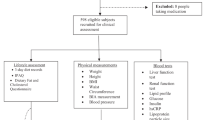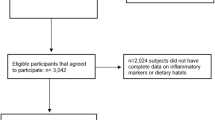Abstract
Background/Objectives:
Inflammation characterizes obesity and is nutritionally modifiable. The hypothesis of this study is that full-fat dairy foods influence circulating inflammatory and atherogenic biomarkers according to fermentation status.
Subjects/Methods:
Thirteen overweight subjects participated in five test meals. Single breakfasts containing control low-fat milk or 45 g fat from butter, cream, yoghurt or cheese were tested over 3 weeks. Plasmas obtained 3 and 6 h were later analyzed for inflammatory markers interleukin (IL)-6, IL-1β, tumor necrosis factor-α and high-sensitive C-reactive protein, and atherogenesis-related markers monocyte chemoattractant protein-1, macrophage inflammatory protein-1α, intercellular adhesion molecule-1 and vascular cell adhesion molecule-1. A 4-week study in 12 subjects compared the effects on these biomarkers of diets containing ∼50 g dairy fat daily as either butter, cream and ice cream (non-fermented) or cheese plus yoghurt (fermented) dairy foods.
Results:
In single-meal study, one outlier subject showed marked increments in biomarkers, hence the following results apply to 12. Within group analysis includes significant falls at 3 h in four inflammatory markers after cream, butter and low fat, and three atherogenesis-related biomarkers after cream. Changes were few after cheese and yoghurt. By 6 h, most values returned to baseline. However, between group analysis showed no differences between the five meals. The 4-week study showed no significant differences in fasting biomarker concentrations between non-fermented and fermented dairy diets.
Conclusions:
Single high-fat meals containing sequentially four different full-fat dairy foods did not increase eight circulating biomarkers related to inflammation or atherogenesis. Among subjects, significant falls occurred at 3 h in inflammatory biomarkers after cream and butter but were not specific for full-fat dairy foods. We could not confirm the reported increments in inflammation after fat meals.
This is a preview of subscription content, access via your institution
Access options
Subscribe to this journal
Receive 12 print issues and online access
$259.00 per year
only $21.58 per issue
Buy this article
- Purchase on Springer Link
- Instant access to full article PDF
Prices may be subject to local taxes which are calculated during checkout
Similar content being viewed by others
References
Aljada A, Mohanty P, Ghanim H, Abdo T, Tripathy D, Chaudhuri A et al. (2004). Increase in intranuclear factor κB in mononuclear cells after a mixed meal, evidence of a proinflammatory effect. Am J Clin 79, 682–690.
Basu A, Devaraj S, Jialal I (2006). Dietary factors that promote or retard inflammation. Arteriscler Thromb Vasc Biol 26, 729–736.
Blackburn P, Despres J-P, Lamarche B, Tremblay A, Bergeron J, Lemieux I et al. (2006). Postprandial variations of plasma inflammatory markers in abdominally obese men. Obesity 14, 1747–1754.
Blake GJ, Libby P, Ridker PM (2005). Inflammatory markers. In: Fuster V, Topplo EJ, Nabel EG (eds). Atherosclerosis and Coronary Heart Disease. Lippincott Williams & Wilkins: Philadelphia.
Depurkar R, Ghanim H, Friedman J, Abuayseh S, Sia CL, Mohanty P et al. (2010). Differential effects of cream, glucose and orange juice on inflammation, endotoxin and the expression of Toll like receptor-4 and suppressor of cytokine signalling-3. Diabetes Care 33, 1013–1017.
El-Khoury D, Hwalla N, Frochot V, Lacorte J-M, Chabet M, Kalopissis AD (2010). Postprandial metabolic and hormonal responses of obese dyslipidemic subjects with metabolic syndrome to test meals, rich in carbohydrate, fat or protein. Atherosclerosis 21, 307–313.
Esposito K, Nappo F, Giugliano F, Di Paulo C, Ciotola M, Barbieri M et al. (2003). Meal modulation of circulating interleukin-18 and adiponectin concentrations in healthy subjects and in patients with type 2 diabetes mellitus. Am J Clin Nutr 78, 1135–1140.
Giugliano D, Ceriello A, Esposito K (2006). The effects of diet on inflammation. J Am Coll Cardiol 48, 677–685.
Libby P, Ridker PM, Maseri A (2002). Inflammation and atherosclerosis. Circulation 105, 1411–1415.
Manning P, Sutherland WHF, McGrath MM, de Jong SA, Walker RJ, Williams MJA (2008). Postprandial cytokine concentrations and meal composition in obese and lean women. Obesity 16, 2046–2052.
Mortensen LS, Hartwingen ML, Brader LJ, Astrup A, Schrezenmeir J, Holst JJ et al. (2009). Differential effects of protein quality on postprandial lipemia response to a fat-rich meal in type 2 diabetes: comparison of whey, casein, gluten, and cod protein. Am J Clin Nutr 90, 41–48.
Nestel P (2008). Effects of dairy fats within different foods on plasma lipids. J Am Coll Nutr 27, 735S–740S.
Panagiotakos DP, Pitsavos CH, Zampelas AD, Chrysobou CA, Stafanidis CI (2010). Dairy products consumption is associated with decreased levels of inflammatory markers related to cardiovascular disease in apparently healthy adults: the ATTICA Study. J Am Coll Nutr 29, 357–364.
Papageorgiou N, Tousoulis D, Psaltopoulou T, Giolis A, Antoniades C, Tsiamis E et al. (2011). Divergent anti-inflammatory effects of different oil acute consumption on healthy individuals. Eur J Clin Nutr 65, 514–519.
Pischon T, Hu FB, Rexrode KM, Girman CJ, Manson JE, Rimm EB (2008). Inflammation, the metabolic syndrome, and risk of coronary heart disease in women and men. Atherosclerosis 197, 392–399.
van Wijk JPH, Cabezas MC, Coll B, Joven J, Rabelink TJ, de Kining EJP (2006). Effects of rosiglitazone on postprandial leucocytes and cytokines in type 2 diabetes. Atherosclerosis 186, 152–159.
Warrensjo E, Jansson J-H, Cederholm T, Boman K, Eliasson M, Hallmans G et al. (2010). Biomarkers of milk fat and the risk of myocardial infarction in men and women: a prospective, matched case-control study. Am J Clin Nutr 92, 194–202.
Wennersberg MH, Smedman A, Turpeinen AM, Retterstol K, Tengblad S, Lipre E et al. (2009). Dairy products and metabolic effects in overweight men and women: results from 6-mo intervention study. Am J Clin Nutr 90, 960–968.
Acknowledgements
The following food companies contributed to a grant-in-aid through the Dairy Health and Nutrition Consortium and provided bulk quantities of butter, cheese and ice cream: Tatura Milk Industries and Bega Cheese, National Foods, Fonterra Australia, Parmalat Australia, Geoffrey Gardiner Foundation, Murray-Goulburn Co-operative, Warrnambool Cheese and Butter, Dairy Innovation Australia.
Author information
Authors and Affiliations
Corresponding author
Ethics declarations
Competing interests
The authors declare no conflict of interest.
Rights and permissions
About this article
Cite this article
Nestel, P., Pally, S., MacIntosh, G. et al. Circulating inflammatory and atherogenic biomarkers are not increased following single meals of dairy foods. Eur J Clin Nutr 66, 25–31 (2012). https://doi.org/10.1038/ejcn.2011.134
Received:
Revised:
Accepted:
Published:
Issue Date:
DOI: https://doi.org/10.1038/ejcn.2011.134
Keywords
This article is cited by
-
Effects of full-fat dairy products on subclinical vascular function in adults with elevated blood pressure: a randomized clinical trial
European Journal of Clinical Nutrition (2020)
-
Effects of cow’s milk beta-casein variants on symptoms of milk intolerance in Chinese adults: a multicentre, randomised controlled study
Nutrition Journal (2017)
-
Effects of Dairy Products Consumption on Health: Benefits and Beliefs—A Commentary from the Belgian Bone Club and the European Society for Clinical and Economic Aspects of Osteoporosis, Osteoarthritis and Musculoskeletal Diseases
Calcified Tissue International (2016)
-
Calcium Supplementation: Is Protecting Against Osteoporosis Counter to Protecting against Cardiovascular Disease?
Current Osteoporosis Reports (2014)



